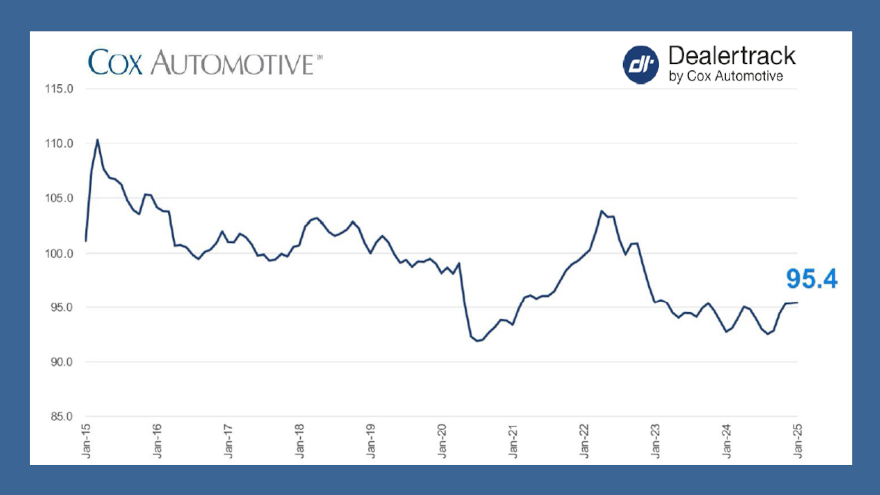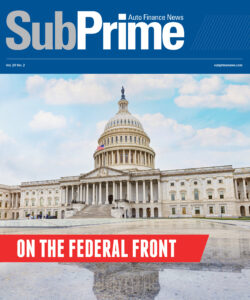Cox Automotive sees credit access flat to start 2025

Dealertrack Credit Availability Index for January. Chart courtesy of Cox Automotive.
Cox Automotive reported the arrival of the January reading, coupled with a slight downward revision of December’s mark, left the Dealertrack Credit Availability Index flat on a sequential comparison.
However, Jonathan Gregory, a senior manager on Cox Automotive’s economic and industry insights team, pointed out the January reading of 95.4 represented a 2.9% lift year-over-year, putting auto credit access at its highest level since March 2023.
“The January Dealertrack Credit Availability Index illustrates mixed results of credit access for auto loans,” Gregory wrote in an analysis that accompanied the new index reading. “Consumers benefited significantly from the growth of subprime loans, followed by an increase in loans with negative equity, loans with extended term lengths, and a decrease in the down payment amount. Meanwhile, the persistence of certain tightening factors — decreasing approval rates and widening yield spreads — was enough to offset all the loosening and hold the index flat.
“This means better borrowing conditions and easier access to auto financing for consumers, particularly when purchasing certified pre-owned vehicles. Lenders are also navigating a mixed environment as credit demand intersects with loosening policies for banks and captives but tightening at auto-focused finance companies and credit unions,” Gregory continued.
Gregory elaborated about the six key drivers of credit access, beginning with approval rates.
Cox Automotive data showed the approval rate decreased by 160 basis points in January.
“The decrease in approval rates and the widening yield spreads mean fewer consumers are getting approved for loans — and at worse rates. These downward trends were the most restrictive measures observed of all credit factors,” Gregory said.
The Cox Automotive expert turned next to yield spreads.
Gregory recapped that the 5-year U.S. Treasury increased by 18 basis points in January, leading to a larger yield spread. He calculated yield spreads grew by 28 basis points, making auto loan rates more favorable than bond yields.
The average auto loan rate increased by 46 basis points in January, according to Cox Automotive tracking.
“Notably, this is the first rate increase since March 2024,” Gregory said. “The widening yield spreads and the increase in average loan rates make borrowing conditions less favorable for consumers, leading to higher monthly payments and increased overall loan costs.
As mentioned earlier, Gregory said the subprime loan share expanded during the opening month of the year.
In fact, Cox Automotive data put the jump at 100 basis points, pushing the subprime share to the highest level since April.
“The larger presence of high-risk loans loosened access for some borrowers, and the impact was by far the most favorable factor of credit availability,” Gregory said.
When it comes to contract terms, Cox Automotive indicated the share of deals that originated with terms greater than 72 months grew by 50 basis points, breaking a four-month trend of decreasing long-term contracts.
“The share of loans with loan terms could mean lower monthly payments, which help consumers,” Gregory said. “It also means consumers will pay off the loan more slowly and potentially spend more on interest over the life of the loan.
“Though there was an increase in January, that was the second-lowest share of loans with terms greater than 72 months since September 2021,” he added.
Perhaps illustrating the mixed landscape of auto financing, Gregory moved on to negative equity, noting contracts originated in January with negative equity spiked by 120 basis points.
“This sharp increase offsets the sharp decrease seen in December,” Gregory said. “While more negative equity loans can signify worsening financial conditions overall, they may expand access for some borrowers.”
Finally, Gregory mentioned the down payment percentage decreased by 10 basis points in January compared to the previous month and fell slightly compared to January of last year.
“Higher down payments can challenge consumers but can also lead to lower monthly payments and less interest over time,” he said.

 View The Latest Edition
View The Latest Edition

